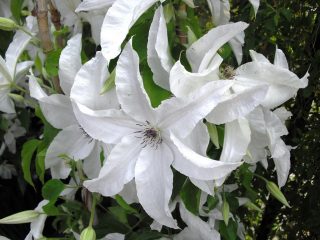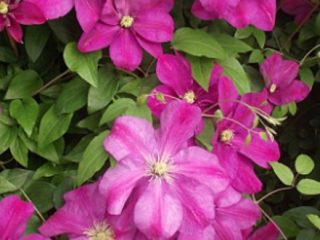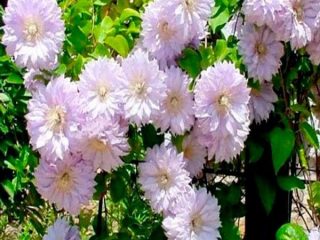Content
A real find in the field of decorative landscape is the elegant cymbalaria. This is a little-known miniature flower from a genus of herbaceous perennials. Rocky paths, small walls or rocky ledges - an unpretentious plant will revive and decorate even the most problematic area. Photos and descriptions of cymbalaria, as well as advice from flower growers will help you grow a flower without unnecessary hassle.
Description of the cymbalaria flower with photo
This is a low-growing groundcover plant with a strong root system and creeping shoots. Its native habitat is the Mediterranean. You can find cymbalaria on the rocky soils of France, in the crevices of ancient buildings in Italy, and on the mountain slopes of Spain.
The official name is Cymbalaria. Comes from the Latin word “symba”, literally translated as “gondola” or “boat”. The flower owes its name to the shape of the leaves, which are slightly pressed in the center and visually resemble small boats. The plant is also known as linaria or dulcimer toadflax.

Cymbalaria grows actively on rocky areas and walls, which explains its popular name “Roman ruins”
The family of the flower is Norichaceae. The growth form is ampelous or herbaceous. An adult plant reaches a height of 5-10 cm. The bush has elongated, creeping, thread-like stems. The shoots are round, hanging or lodging. They grow up to 50 cm wide, and in warm weather - up to 90 cm. The evergreen leaves of the bush resemble ivy greens. Arranged oppositely or whorled (ring-shaped).
Sheet Description:
- ivy shape;
- heart-shaped base;
- rounded or pointed top;
- dark green rich color;
- average length – 11-13 mm, width – 15-17 mm;
- consists of 5-7 round or triangular lobes.
Cymbalaria is decorated with numerous small flowers. Their size in diameter does not exceed 1 cm. They grow on branched stems and bloom in the axils of the leaves. Visually associated with violet flowers. The predominant color is pale purple (variations depend on the species). After flowering, fruits are formed. In Cymbalaria these are rounded seed pods.

Cymbalaria has a long flowering period; garlands of soft lilac flowers delight the eye from April until the first cold weather in September
How aggressive is Cymbalaria?
The plant is an invasive species: it was accidentally introduced into new territories, where it did not die, but is actively developing and occupying new areas. Due to its increased adaptability and survivability, perennial cymbalaria has an average level of aggressiveness. Even on rocky soil, the flower grows quickly, forming a carpet. Due to its small size, the plant does not drown out or clog its neighbors.But over time, long shoots of color entwine nearby crops, disturbing the overall composition of the garden.
Types and varieties
In the general family Cymbalaria, scientists additionally identify about 15 subspecies. In warm and temperate climates, no more than five species of herbaceous plants grow.
Wall cymbalaria
Cymbalaria Muralis (Cymbalaria Muralis), better known as the wall plant. In the wild, the flower is found throughout Southern Europe. Thanks to migration flows, the plant's seeds also reached other regions: Scandinavia, the British Isles, and some regions of Russia. The average height of the bush is 6-7 cm. The subspecies has fragile thread-like stems that easily entwine even piles of stones. The leaves of the flower are small, ivy-shaped. The plate is dark green, the lower part is painted purple. The flowers are pale lilac or white.

The flowers of the wall cymbalaria are similar to the flowers of snapdragons, these plants belong to the same family.
Hairy
Cymbalaria Pilosa (Cymbalaria Pilosa). Native lands of growth are mountainous European regions. Most often, this species can be found on rocky screes. The Cymbalaria hairy bush does not exceed 5 cm in height. The plant forms dense cushion-shaped growth. There are weightless fibers on the leaves. The flowers are pale blue or lilac.

Cymbalaria hairy blooms throughout the summer with small flowers with a characteristic yellow sky
Pale
Cymbalaria Palida (Palida cymbalaria).The growing area extends to the mountainous areas of Europe. The plant prefers to settle on clusters of large rocky blocks in the Apennines. The height of the bush varies from 5 to 10 cm. The shoots grow, forming peculiar pillows. The leaf blades are slightly pubescent and consist of 3-5 lobes. The flowers are blue-violet.

The decorative subspecies grows well both on poor soils and in rocky crevices with a minimum of soil
Three-blade
Cymbalaria Aequitriloba (Cymbalaria Equitriloba). Homeland - Mediterranean Europe. The perennial bush has small fleshy leaves, the height of the shoots does not exceed 5-10 cm. The flowers are painted pink. The flowering period is from June to September.

In the Balearic Islands, the subspecies of dulcimer triloba is under state protection
Liverfolia
Cymbalaria Hepaticifolia (Cymbalaria Hypericifolia). The difference between the species is the white flowers. Medium sized bushes. The corolla is two-lipped, painted bright yellow. The leaves are fleshy, with a characteristic silvery tint.

White flowers with a yellow core will highlight and add uniqueness to any area
Planting and caring for cymbalaria in open ground
Cymbal toadflax is a tenacious and unpretentious plant. It grows well in partially shaded areas, full shade or morning sun. The optimal place for planting a flower is in areas with poor rocky soil and dim light.
Landing rules
Under natural conditions, the plant settles in a limited space: between stones, in the spaces of walls, on ledges and in crevices. Therefore, there is no need to allocate large garden areas for cymbalaria. The bushes are planted at a distance of 40 cm from each other. The average planting density is nine plants per 1 square meter. m.
The plant prefers alkaline (calcareous) soil. To do this, add the following to the soil:
- sand;
- small crushed stone;
- dolomite flour.
Cymbalaria does not like scorching sunlight. The bushes are comfortable in diffused light or in complete shade. The flower, like any other perennial, is planted in the ground from spring to autumn. But the best period for planting is March/April (immediately after the last frost). To plant Cymbalaria in rocky soil, the roots are first immersed in thick mud. Then they are carefully placed in shallow holes, lightly pressing the soil.
Watering and fertilizing
It is important to provide the plant with regular moderate watering. The soil under the cymbalaria bush should always be slightly moist. In this case, you should not flood the flowers or allow moisture to stagnate.
Cymbalaria practically does not need fertilizers or fertilizing. Before planting, you can add well-rotted organic matter to rocky soil. To ensure lush flowering, it is recommended to enrich the soil with complex mineral compounds for decorative foliage plants. In total, they fertilize three times per season: at the beginning of the growing season, in the middle and end of summer.

If there is an excess of nutrients in the soil, cymbalaria does not bloom, and a rapid growth of green mass occurs
Trimming
Carry out when the stems grow excessively. Cymbalaria calmly tolerates the procedure: it does not wither or fade. In adjacent areas, pruning is carried out using garden shears or ordinary scissors. In large areas, removing shoots with a mower is allowed.
Wintering
The herbaceous plant tolerates temperatures down to -15 °C.In regions with cold climates, bushes are covered with agrofibre, a layer of mulch or spruce branches. For a warming and draining effect, the soil under the shoots is sprinkled with sand and wood ash. In snowless winters with frosts, cymbalaria freezes slightly.

With the arrival of heat, the plant regenerates or quickly recovers by self-sowing
Reproduction methods
The natural method of propagation of cymbalaria is unusual. Flowers rise above the leaves and become accessible to bees and other pollinators. After the seeds ripen, the peduncle stretches and bends. Cymbalaria seeds are spontaneously dispersed to the neighboring territory, where they germinate the next year.
Propagation of wall cymbalaria occurs easily and quickly. The preferred method is shoot division. They take root easily and can be planted in open ground after pruning. The stems of the plant take root almost immediately and begin to grow green mass.
Diseases and pests
Cymbalaria is distinguished by its resistance and strong immunity to most diseases. Powdery mildew develops when the soil is moistened for a long time.

The main sign of cymbalaria infection with powdery mildew is a white powdery coating on the leaves.
Folk remedies help only at the initial stage. Optimal use of chemicals. Fundozol, Amistar, Acrobat, Topaz - from the list you can choose the appropriate product for treating the plant.
Spider mites pose a danger to the bush. The pest becomes more active in dry and hot weather. A light transparent web appears on leaves, shoots and flowers - a characteristic sign of parasite activity. The fight consists of spraying with insecticides.

Aktara or Aktellik show a detrimental effect on ticks
In rainy weather, cymbalaria leaves are attacked by slugs and snails. Pests leave through holes and traces of mucus on their surface. For small lesions, manual collection is carried out. Among the folk methods is dusting greens with hot pepper, mustard or ash. Among the chemicals available for eliminating mollusks, the following drugs are available: Slug Eater, Anti-Slug Eater, and Thunderstorm.
Application in landscape design
Cymbalaria is a classic option for decorating rock gardens and rocky gardens. The shoots beautifully entwine retaining walls and relief irregularities. Organically fill the space between street tiles, paving stones, and gravel.

Miniature flowers and an abundance of greenery will highlight and refresh rocky walls and Japanese gardens
Landscape designers use herbaceous plants to create a background in rock gardens and to organize alpine slides. The flower is also actively used for other decorative purposes:
- decoration of facade walls;
- filling cracks;
- masking unsightly corners (compost heap);
- landscaping areas with rocky soil where other crops do not grow well.
Cymbalaria can also be planted in separate pots. The shoots, descending, form a beautiful waterfall of bright green foliage. The plant is planted in mixed flower beds with caution. Due to excessive growth, the stems quickly entwine neighboring crops.
Conclusion
Photos and descriptions of cymbalaria prove that this is a unique specimen for decorating a site. The high growth rate allows the shoots to entwine low walls in a short time, climbing even into inconspicuous crevices.Ease of care, hardiness, winter hardiness and easy cultivation are the main advantages of this herbaceous plant. Cymbalaria will actively grow and bloom en masse even in poor rocky soil.








